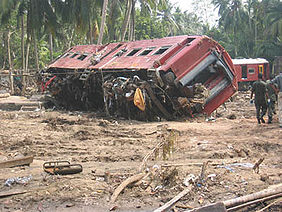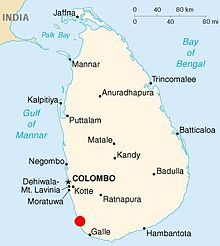- Train no. 8050 Tsunami-Rail Disaster
-
Train No.8050 Tsunami - Rail Disaster 
Details Date 26 December 2004 Location Peraliya, Hikkaduwa Country Sri Lanka Rail line Coastal line Operator Sri Lanka Railways Type of incident Flood Cause Tsunami Statistics Trains 1 Train Deaths Exact figures unknown, at least 1,700+ Injuries unknown Train No.8050 Tsunami - Rail Disaster was a rail disaster with the highest count of deaths in history. It occurred when a crowded passenger train was destroyed on a coastal railway in Sri Lanka by the tsunami which followed the 2004 Indian Ocean Earthquake, and resulted in the greatest loss of life in railroad history. More than 1,700 people died, much higher than the previous rail disaster with most fatalities, the Bihar train disaster in India in 1981.
Contents
Train
The train was a regular service train operating between the cities, Colombo and Galle. The route it took runs along the southwestern coast of Sri Lanka, and at Telwatta, the line is about 200 metres (660 ft) inland. On Sunday, 26 December 2004, during both theBuddhist full moon holiday and Christmas holiday weekend, it left Colombo shortly after 6:55 A.M. with a capacity load of around 1,500 passengers on board.
Tsunami waves strike the crowded train
At 9:30 A.M., in the village of Peraliya, near Telwatta, the beach was hit by the first of the huge waves thrown up by the earthquake, which had recently struck off the coast of Sumatra,Indonesia. The train came to a halt as water surged around it. Hundreds of local people, believing the train to be secure on the rails, climbed on top of the train to avoid being swept away. Others stood behind it, hoping the train would take the force of the water. The wave caused flooding in the carriages and began to cause panic amongst the passengers. The next wave, by far the biggest of the entire day at over 18 feet (5.5 m) high, picked the train up and smashed it against the trees and houses which lined the track, crushing those seeking shelter behind it. The eight carriages were so packed with people that the doors could not be opened, and they filled with water, drowning almost everyone inside, as the water washed over the wreckage several more times.
The casualties
Due to the huge scale of the disaster, the authorities were unable to cope with the devastation, and emergency services and military forces were so stretched that immediate rescue was not an option. In fact, the Sri Lankan authorities had no idea where the train was for several hours, until it was spotted from the air. The local emergency services were destroyed, and it was a long time before help arrived. Dozens of people badly injured in the disaster died in the wreckage during the day, and many bodies were not retrieved for over a week. Some families descended on the area determined to find their relatives.
According to the Sri Lankan authorities, only a few dozen people on the train survived. The estimated death toll was at least 1,700 people, and probably over 2,000, although only approximately 900 bodies were recovered by the authorities, as many were swept out to sea or taken away unofficially by relatives. The town of Peraliya was also destroyed, losing hundreds of citizens to the waves and all but ten buildings. Over 200 of the bodies retrieved were not identified or claimed, and were buried three days later in a Buddhist ceremony near the torn railway line.
Aftermath
The first anniversary ceremonies were held amongst the rebuilt town alongside the repaired railway, which still operates a Colombo to Galle service, employing the same guard who was on the train and survived the disaster.[citation needed] The Train, now restored with the same locomotive (Class M2a No. 591) and two of its original carriages, returned to Paraliya on 26 December 2008, four years after the disaster. A religious ceremony and a memorial was held to remember those who lost their lives four years ago. It has now returned to regular service on the coastal line.[1]
See also
Notes
- ^ Daily Mirror Online Edition, 26 December 2008.
External links
- BBC News Report
- USA Today Report
- Traveler's report
- BBC One year anniversary
- Sri Lankan account
- The Peraliya Official Website
- Steele, Jonathan. "One train, more than 1,700 dead.", The Guardian. 29 December 2004.
- Daily Mirror 26.12.2008
Coordinates: 6°10′08″N 80°05′28″E / 6.169°N 80.091°E
Railway accidents in 2004 Location and date Moscow, Russia (6 February) • Tebay, England (15 February) • Nishapur, Iran (18 February) • Ryongchon, North Korea (22 April) • Karanjadi, India (17 June) • Ufton Nervet, England (6 November) • Berajondo, Australia (15 November) • Peraliya, Sri Lanka (26 December)
Categories:- Railway accidents in Sri Lanka
- 2004 Indian Ocean earthquake
- Railway accidents in 2004
Wikimedia Foundation. 2010.

